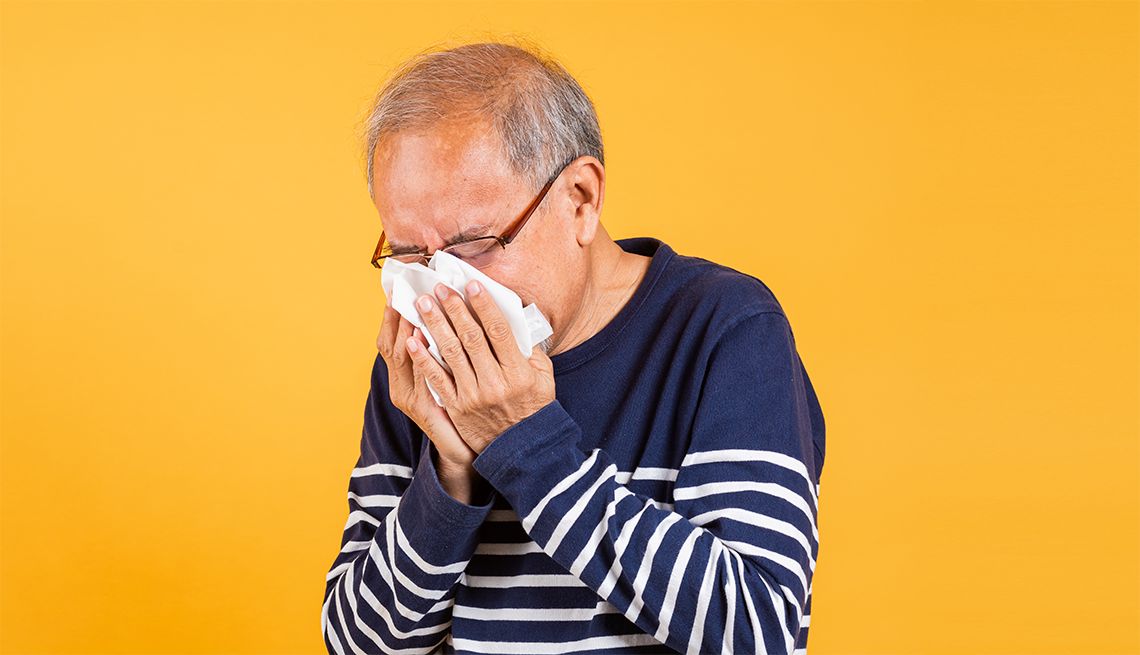
- Select a language for the TTS:
- UK English Female
- UK English Male
- US English Female
- US English Male
- Australian Female
- Australian Male
- Language selected: (auto detect) - EN
Play all audios:
If you’ve been sneezing, itching and wiping away at watery eyes, you are not alone. The Centers for Disease Control and Prevention (CDC) says about a quarter of U.S. adults suffer from
seasonal allergies, and interestingly, the burden is more likely to fall on older adults. While 24.7 percent of adults ages 18 to 44 have seasonal allergies, roughly 28 percent of people 45
to 64 and 26.4 percent of adults ages 65 to 74 experience them, data shows. If you’re among the pollen-suffering population, you may feel worse this year than you did, say, a decade ago.
It’s not all in your head: Allergy seasons are becoming longer and more intense in many areas of the country due to warming temperatures that cause plants to produce pollen earlier in the
spring season and keep ragweed around longer in the fall, the Environmental Protection Agency explains. It’s also possible for allergy symptoms to worsen as you age, says Margaret Kuder,
M.D., an allergist at the Cleveland Clinic; one reason is immune system changes. “A lot of times, if people have pollen allergies, it’s not something that starts later in life. Usually, it’s
been around in some form throughout most of adulthood and even childhood, and then sometimes, it can get worse as we get into adulthood,” Kuder says. However, there are a number of things
you can do to get some relief this spring. Here are six tips recommended by allergists: 1. GET A NASAL SPRAY — AND START USING IT RIGHT AWAY. Kuder says her go-to is an intranasal spray for
allergy symptom relief (including eye symptoms), which you can get over the counter. “They work right at the source of where you’re having symptoms, and you don’t have to have that whole
body exposure you can have with pills,” she says. She typically starts patients with an intranasal steroid spray, like fluticasone (Flonase) or triamcinolone (Nasacort), which are low-dose
and help to reduce the inflammation from allergies. “And then if the nasal steroids are not giving full relief, a lot of times, we’ll add on intranasal antihistamine spray,” she adds, such
as azelastine (Astelin or Astepro). The trick is to start the steroid sprays early in the season, says J. Allen Meadows, M.D., an allergist at Jackson Hospital in Montgomery, Alabama, and
past president of the American College of Allergy, Asthma and Immunology. “They take about 10 days to start working and a month or so to have an actual effect,” he says. “So you’ve got to be
faithful and use those every day, but they’re quite effective and really not very expensive at all.” Video: 4 Tips to Help Combat Seasonal Allergies 2. TAKE AN ALLERGY PILL. Don’t have time
to wait for the sprays to start working and need relief fast? Over-the-counter oral medications take about an hour to kick in, though Meadows says they are less effective than the sprays.
Examples of over-the-counter antihistamines for allergies include loratadine (Claritin), cetirizine (Zyrtec) and fexofenadine (Allegra). Meadows adds that you can usually find the best deals
on these medications at wholesale clubs. If you opt for an antihistamine pill, make sure you’re getting a non-sedating one. First-generation antihistamines such as diphenhydramine
(Benadryl) can have a sedating effect and can also make it harder to urinate. Second-generation antihistamines, like the allergy pills listed above, are less likely to cause drowsiness and
other side effects, Kuder says. Some people reach for decongestants like pseudoephedrine (Sudafed) during allergy season to help relieve stuffiness. If you have high blood pressure, talk to
your doctor before taking a decongestant since the medication can worsen the condition.

:max_bytes(150000):strip_icc():focal(999x0:1001x2)/queen-elizabeth-19-acd642715454442eb281e80bf11c003c.jpg)






